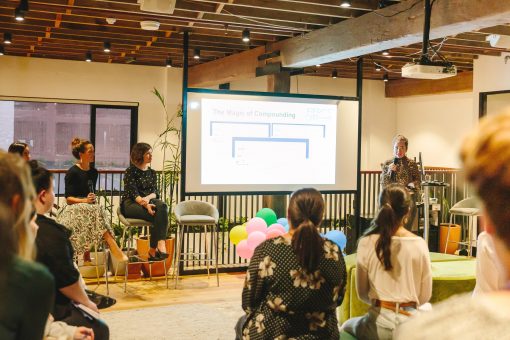A dream for many women is to be financially independent and free from worry about money. #Eachforequal marks the global theme for International Women’s Day, celebrated this Sunday, 8 March 2020. In line with this theme, we share some financial gems and investing tips to help empower women financially.
Bridging the gap
The financial disparity between men and women in Australia is an important topic to address as we continue to see gender-based inequities present themselves.
We live in an age where women are predicted to outlive men by almost half a decade. This begs the question, what can women do differently over the course of their lives to help them achieve more financial independence and control?
We know that many women take time out of the workforce to care for children; that on average women’s remuneration is 13.9% less than men; that on average women retire with 37% less in super and on top of this, will outlive men.
It doesn’t feel like the odds are stacked in our favour does it? This sense of inequality leads to many women feeling disempowered, stressed and fearful of their financial futures.
How can we flip this so more women feel in control, positive and connected to their financial futures. What would it take to get there?
Learning key financial gems
In my mind, there are some financial gems that all women should learn as early as possible to help them map out a future financial plan:
1) The importance of goal setting and your savings rate
Many of us move through life without setting clear financial goals, spending more than we earn and not thinking about the future.
Goal setting is about investing time in yourself, to sit down and think about what you might want at different stages in your life.
Examples could be to have enough savings by the time you’re 25 to fund a European holiday, a 20% deposit for your first home by the time your 40 and to be free of debt by 60.
Mapping out your financial goals will help you clearly visualise what you want, then you can think about what you need to do to get there.
Of course, they may change over time, but no matter what the goal, you’ll have the financial plan in place to reach it.
Goal setting will also help motivate you to increase your savings rate. Many people think growing your wealth requires earning high returns, but actually your savings rate is just as important.
By saving 20% of your salary and earning a 6% return you’ll be better off over 10, 20 and 30 years compared to someone saving 10% of their salary and earning a 9% return.

Sarah King, Head of Advice, explains the power of compound interest at Fierce Girl Finance Investing 101 event.
2) Saving versus investing and getting comfortable with risk
Many women fall into the trap of ‘saving for life’. By this I mean keeping their life long savings parked in a bank account or term deposit, earning a low rate of interest for decades. Yes, it’s safe and secure as you’re pretty much guaranteed you won’t lose your money.
The reality is if you’re interested in creating wealth, parking your money in a savings account is risky because your money isn’t growing (keeping ahead of inflation).
On top of that, the earnings are taxed at your marginal rate. If you’re in the highest tax bracket, that’s close to half the earnings lost in tax!
This approach is ok if you’re saving for a short-term goal, so think anywhere between 3 months to 3 years. Short-term goals are typically lifestyle goals like buying a car, saving for wedding, a family holiday or home deposit.
Where you want immediate liquidity and don’t want to run the risk of having less money than you deposited. For this security, you’re willing to accept a lower rate of return.
Based on current rates its typically around 1.5%-2.8% p/a. Not a lot of bang for your buck!
A smart way to earn more bang for your buck is by investing your money. If you don’t need to access your money in the medium to long term (3 years or more) then put it to work!
Investing your money into a low cost, diversified portfolio of investments will help your money to grow within the range of 5-9% p/a over the long term depending on your asset allocation.
If you’re unfamiliar with investing or don’t want to do it yourself, there are many low cost, automated investment advisers, like Stockspot, who will manage it all for you.

Sarah King, Head of Advice, shares her own investing experience at Fierce Girl Finance Investing 101 event.
Practical tips to grow your money
Now you’re armed with the gems, what are some practical tips to help you grow your money at different stages in your life:
20s-30s
First things first. Set good financial habits now (the earlier the better), and learn how to budget. The Barefoot Investor money buckets method might work for you or you may be a fiend on excel.
Whatever works for you, at a minimum stick to the 80/20 rule: Try and save or invest 20% of what you earn and use the 80% to cover living expenses including your rent or mortgage.
-
Before investing, make sure you have some savings built up. Also known as a rainy day fund of around 3-6 months worth of living expenses set aside so you can access it in an emergency.
-
It can be appropriate to take more risk. If you’re comfortable with more ups and downs in your portfolio, choose a portfolio with a higher allocation to growth investments like shares and less to defensive assets like bonds. Your money has years to grow so taking more risk at this stage will help your money to grow more over the long term through the compounding of returns.
-
Always invest into a broad mix of investments like Australian shares, Global shares, bonds and gold. This helps to reduce your risk. Exchange Traded Funds (ETFs) are one of the best ways to invest in hundreds of different companies around the world.
-
Sort out your super. Make sure you’re in a low fee super fund (paying less than 1% p/a in fees) with an asset allocation that’s suitable for the long term. This is typically a 70%-90% allocation to growth assets like shares and property and the rest in bonds and cash.
-
Make sure your super is consolidated if you’re changing employers frequently to avoid excess fees!
30s-40s
It may be babies, aiming for a seat in the c-suite or a 180 degree career change, your 30s and 40s isn’t necessarily going to be A-typical.
-
If you earn a bonus each year or get a salary increase, try to put all or some of it into your investment portfolio.
-
Consider adding more than the statutory 9.5% p/a of your income into superannuation. If you have the capacity increase it by 1%, 2% or even 5% p/a, with years to grow it will make a huge impact to your retirement nest egg.
-
Ensure your asset allocation is still suitable for your risk appetite and time horizon.
50+
At this age preserving your wealth becomes increasingly important as you work towards retirement years.
-
Pay down any debt as quickly as you can with the goal of retiring debt free.
-
It may be time to look at downsizing from the family home to realise some capital that you can use to fund a smaller place and free up more funds for your retirement.
-
Make sure you have an up to date will.
-
Having a balanced asset allocation with a 60% allocation to growth assets and 40% allocation to defensive assets is more common. You want your wealth to grow, but also be protected along the way.
-
The average life expectancy is increasing for males and females, so if you still catch yourself with a high proportion of your money sitting in fixed income investments, you still have time to put the funds to work and enjoy capital growth from investing!
No matter your stage of life, it’s never too late to set financial goals and map out a plan for your future. Investing your money will help you to get there faster, and it’s easy, once you know how.
Find out how Stockspot makes it easy to grow your wealth and invest in your future.




